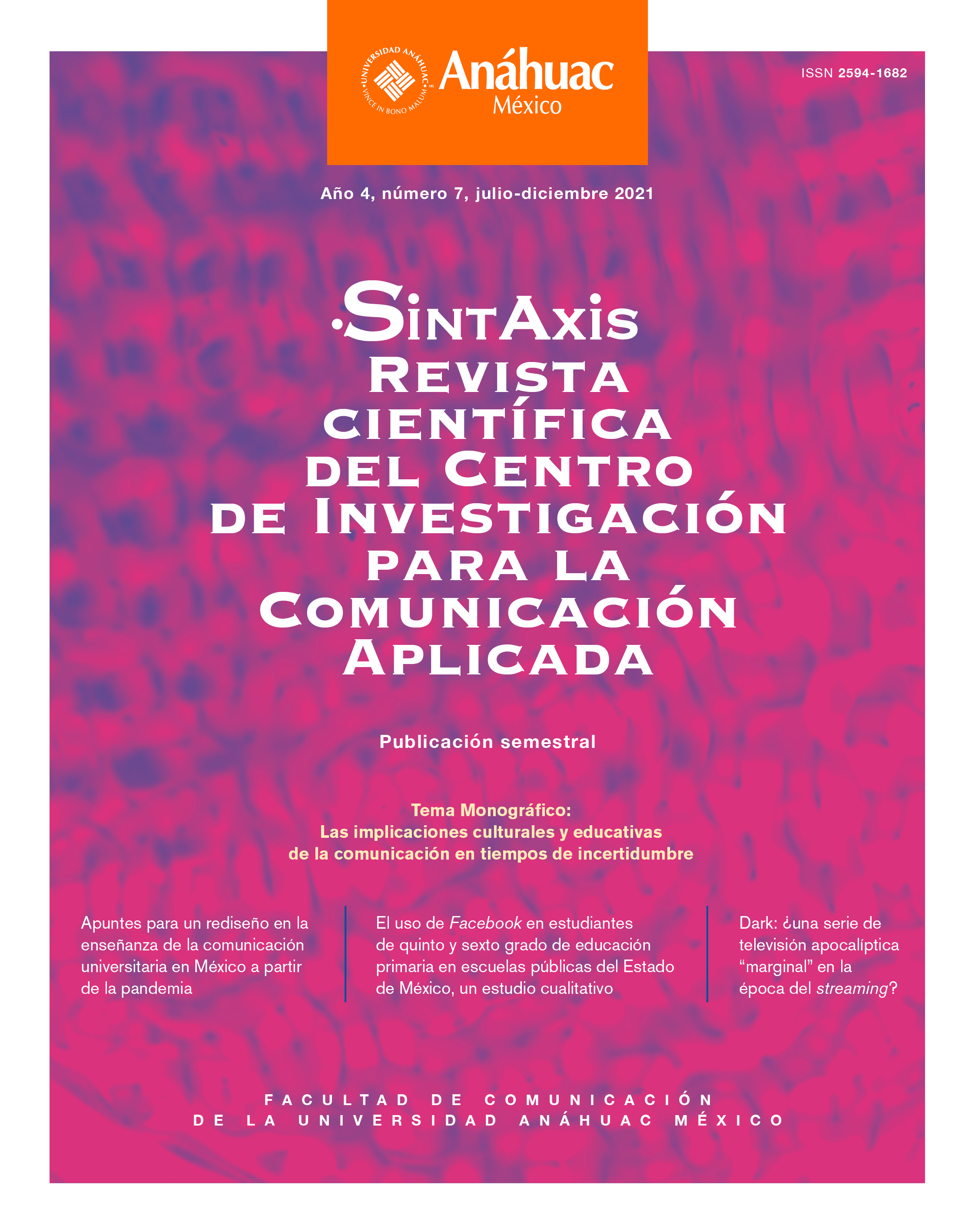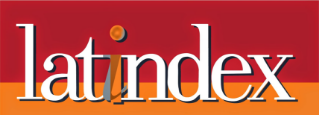La credibilidad de los medios y de la información sobre la salud entre los habitantes de la Ciudad de México durante la pandemia COVID-19 (julio-diciembre 2020)
DOI:
https://doi.org/10.36105/stx.2021n7.04Palabras clave:
credibilidad, información para la salud, medios, nuevos medios, pandemiaResumen
En medio de un panorama mediático amplio y diverso, entre los viejos y los nuevos medios, no está muy clara la manera en que las personas se informan sobre temas de la salud y mucho menos se conoce la credibilidad que se atribuye hacia los medios y hacia sus contenidos, por lo que se realizó una investigación cuantitativa de corte exploratorio y descriptivo a 151 habitantes de la Ciudad de México mediante la aplicación de un cuetionario durante la pandemia provocada por la covid-19 (julio-diciembre 2020), encontrándose que las páginas web especializadas son la principal fuente de información y las que poseen una mayor credibilidad en temas de salud; sin embargo, con una muestra tan pequeña, los resultados no son concluyentes y es necesario realizar una investigación más amplia, incluso de corte cualitativo para profundizar más en los elementos que conducen a las personas a buscar y evaluar este tipo de información.
Descargas
Referencias
BBC News (25 de mayo de 2020). Coronavirus | De enfermedad respiratoria a multisistémica: cómo en pocas semanas cambió radicalmente lo que sabemos sobre la COVID-19. BBC News. Mundo. Noticias. Recuperado de: https://bbc.in/30soGXz
Benoit, W. L. (1987). Argumentation and credibility appeals in persuasion. Southern Speech Communication Journal, 52(2), 181-197. https://doi.org/10.1080/10417948709372687
Borah, P., & Xiao, X. (2018). The importance of “likes”: the interplay of message framing, source, and social endorsement on credibility perceptions of health information on Facebook. Journal of Health Communication, 23(4), 399–411. https://doi.org/10.1080/10810730.2018.1455770
Carter, R. F. & Greenberg, B. S. (1965). Newspapers or television: Which do you believe? Journalism Quarterly, 42(1), 29-34. https://doi.org/10.1177/107769906504200104
Chang, Y. S., Zhang, Y. & Gwizdka, J. (2021). The effects of information source and eHealth literacy on consumer health information credibility evaluation behavior. Computers in Human Behavior, 115, 1-33. https://doi.org/10.1016/j.chb.2020.106629
Cheung, C. & Tse, J. (2008). Institutional trust as a determinant of anxiety during the SARS crisis in Hong Kong. Social Work in Public Health, 23(5), 41-54. https://doi.org/10.1080/19371910802053224
Choi, W. (2020). Older adultsʼ credibility assessment of online health information: an exploratory study using an extended typology of web credibility. Journal of the Association for Information Science & Technology (JASIST) , 71(11), 1295-1307. https://doi.org/10.1002/asi.24341
Chou, S. W. Y., Gaysynsky, A. & Cappella, J. N. (2020). Where we go from here: health misinformation on social media. American Journal of Public Health, 110(S3), S273-S275. https://doi.org/10.2105/AJPH.2020.305905
Clayman, M. L., Manganello, J. A., Viswanath, K., Hesse, B. W. & Arora, N. K. (2010). Providing health messages to Hispanics/Latinos: understanding the importance of language, trust in health information sources, and media use. Journal of Health Communication, 15(sup3), 252-263. https://doi.org/10.1080/10810730.2010.522697
Cronkhite, G. & Liska, J. (1976). A critique of factor analytic approaches to the study of credibility. Communication Monographs, 43(2), 91-107. https://doi.org/10.1080/03637757609375920
Delia, J. G. (1976). A constructivist analysis of the concept of credibility. Quarterly Journal of Speech, 62(4), 361-375. https://doi.org/10.1080/00335637609383350
De Meulenaer, S., De Pelsmacker, P., & Dens, N. (2018). Power distance, uncertainty avoidance, and the effects of source credibility on health risk message compliance. Health Communication, 33(3), 291-298. https://doi.org/10.1080/10410236.2016.1266573
Eagly, A. & Chaiken, S. (1993). The psychology of attitudes. Orlando, FL: Harcourt Brace.
Embacher, K., McGloin, R., & Richards, K. (2018). When women give health advice online, do we listen? The effect of source sex on credibility and likelihood to use online health advice. Western Journal of Communication, 82(4), 439-456. https://doi.org/10.1080/10570314.2017.1367028
Flanagin, A. J. & Metzger, M. J. (2007). The role of site features, user attributes, and information verification behaviors on the perceived credibility of web-based information. New Media & Society, 9(2), 319-342. https://doi.org/10.1177/1461444807075015
Fox, M. (11 de julio de 2020). Así afecta el coronavirus todo el cuerpo. CNN Español. Recuperado de: https://cnn.it/3rK2xQN
Gantz, W. (1981). The influence of researcher methods on television and newspaper news credibility evaluations. Journal of Broadcasting, 25(2), 155-169. https://doi.org/10.1080/08838158109386439
Gass, R. H. & Seiter, J. S. (1999). Persuasion, social influence, and compliance gaining. Boston, MA: Allyn & Bacon.
Gaziano, C. & McGrath, K. (1986). Measuring the concept of credibility. Journalism Quarterly, 63(3), 451-462. https://doi.org/10.1177/107769908606300301
Google (2021). See what was trending in 2020 México. Google. Trends. Recuperado de: https://bit.ly/3bxTMU5
Greenberg, B. S. & Roloff, M. E. (1974). Mass media credibility: research results and critical issues. Washington, DC: American Newspaper Publishers Association.
Gunther, A. C. (1988). Attitude extremity and trust in media. Journalism Quarterly, 65(2), 279-287. https://doi.org/10.1177/107769908806500203
Gunther, A. C. (1992). Biased press or biased public? Attitudes toward media coverage of social groups. Public Opinion Quarterly, 56(2), 147-167. https://doi.org/10.1086/269308
Hajli, M. N., Sims, J., Featherman, M. & Love, P. E. D. (2015). Credibility of information in online communities. Journal of Strategic Marketing, 23(3), 238-253. https://doi.org/10.1080/0965254X.2014.920904
Hawn, C. (2009). Take two aspirin and tweet me in the morning: how Twitter, Facebook, and other social media are reshaping health care. Health Affairs, 28(2), 361-368. https://doi.org/10.1377/hlthaff.28.2.361
Hovland, C. I., Janis, I. L., & Kelley, H. H. (1953). Communication and persuasion. New Haven, CT: Yale University Press.
IAB (marzo, 2019). Estudio de consumo de medios y dispositivos entre internautas mexicanos. 11a. edición. Ciudad de México, México: Kantar-IAB México-Televisa Digital.
IAB (septiembre, 2020). Estudio de consumo de medios y dispositivos entre internautas mexicanos. 12a. edición. Ciudad de México, México: Kantar-IAB México-Televisa Digital.
IFT (2019). Encuesta nacional de consumo de contenidos audiovisuales 2019. Ciudad de México, México: Instituto Federal de Telecomunicaciones.
Ihlen, Ø. (2020). Science communication, strategic communication and rhetoric: the case of health authorities, vaccine hesitancy, trust and credibility. Journal of Communication Management, 24(3), 163-167. https://doi.org/10.1108/JCOM-03-2020-0017
INEGI (2021). Población. Población total. INEGI. Recuperado de: https://bit.ly/3sCNA2n
Jackson, D. N., Peterson, E. B., Blake, K. D., Coa, K. & Chou, W. Y. S. (2019). Americans’ trust in health information sources: trends and sociodemographic predictors. American Journal of Health Promotion, 33(8), 1187-1193. https://doi.org/10.1177/0890117119861280
Klawitter, E., & Hargittai, E. (2018). Shortcuts to well being? Evaluating the credibility of online health information through multiple complementary heuristics. Journal of Broadcasting & Electronic Media, 62(2), 251-268. https://doi.org/10.1080/08838151.2018.1451863
Kemp, S. (2021). Digital 2020: Mexico. DataReportal. Recuperado de: https://bit.ly/3sFuPLC
Lee, R. S. (1978). Credibility of newspaper and TV news. Journalism Quarterly, 55(2), 282-287. https://doi.org/10.1177/107769907805500209
Levinson, P. (2013). New new media. 2a. ed., Nueva York, NY: Penguin Academics.
Machackova, H., & Smahel, D. (2018). The perceived importance of credibility cues for the assessment of the trustworthiness of online information by visitors of health-related websites: The role of individual factors. Telematics & Informatics, 35(5), 1534-1541. https://doi.org/10.1016/j.tele.2018.03.021
Masílamani, V., Sriram, A., & Rozario, A. M. (2020). Alfabetización en e-Salud de los jóvenes: credibilidad y calidad de la información sanitaria con móviles en la India. Comunicar, 28(64), 85-95. https://doi.org/10.3916/C64-2020-08
Meyer, P. (1988). Defining and measuring credibility of newspapers: developing an index. Journalism Quarterly, 65(3), 567-574. https://doi.org/10.1177/107769908806500301
MSP (28 de febrero de 2020). Primer caso de coronavirus en México. Medicina y Salud Pública. Recuperado de: https://bit.ly/2ODy7ki
Newhagen, J. & Nass, C. (1989). Differential criteria for evaluating credibility of newspapers and TV news. Journalism Quarterly, 66(2), 277-284. https://doi.org/10.1177/107769908906600202
O’Keefe, D. J. (1990). Persuasion: theory and research. Newbury Park, CA: Sage.
Palanisamy, B., Gopichandran, V. & Kosalram, K. (2018). Social capital, trust in health information, and acceptance of measles-rubella vaccination campaign in Tamil Nadu: a case–control study. Journal of Postgraduate Medicine, 64(4), 212-219. https://doi.org/10.4103/jpgm.JPGM_249_17
Petty, R. E., & Cacioppo, J. T. (1981). Attitudes and persuasion: classic and contemporary approaches. Dubuque, IA: William C. Brown.
Popescu, S. D., Popescu, A. O., Maior, D., Dănilă, M., Dobria, M., & Nădăşan, V. (2018). Widely accepted credibility criteria for online health-related information are not correlated with content quality of stroke webpages in two languages of Central and Eastern European countries. Journal of Interdisciplinary Medicine, 3(3), 196-201. https://doi.org/10.2478/jim-2018-0031
Reagan, J. & Zenaty, J. (1979). Local news credibility: newspapers vs. TV news revisited. Journalism Quarterly, 56(1), 168-172. https://doi.org/10.1177/107769907905600127
Rimmer, T. & Weaver, D. (1987). Different questions, different answers? Media use and media credibility. Journalism Quarterly, 64(1), 28-44. https://doi.org/10.1177/107769908706400104
Sbaffi, L. & Rowley, J. (2017). Trust and credibility in web-based health information: a review and agenda for future research. Journal of Medical Internet Research, 19(6): 1-16. https://doi.org/10.2196/jmir.7579
Secretaría de Salud (2020). Conferencia 30 de diciembre de 2020. Coronavirus. Recuperado de: https://bit.ly/3v6Vbst
Secretaría de Salud (2021). Información accesible. Coronavirus. Recuperado de: https://bit.ly/3l5eVbh
Self, C. C. (1996). Credibility. En M. B. Salwen & D. W. Stacks (eds.), An integrated approach to communication theory and research (pp. 421-441). Mahwah, NJ: Erlbaum.
Shah, Z., Surian, D., Dyda, A., Coiera, E., Mandl, K. D. & Dunn, A. G. (2019). Automatically appraising the credibility of vaccine-related web pages shared on social media: a Twitter surveillance study. Journal of Medical Internet Research, 21(11), 1-14. https://doi.org/10.2196/14007
Shin, D.-H., Lee, S., & Hwang, Y. (2017). How do credibility and utility play in the user experience of health informatics services? Computers in Human Behavior, 67: 292-302. https://doi.org/10.1016/j.chb.2016.11.007
Song, S., Zhang, Y. & Yu, B. (2020). Interventions to support consumer evaluation of online health information credibility: a scoping review. International Journal of Medical Informatics, 145, 1-11. https://doi.org/10.1016/j.ijmedinf.2020.104321
Stamm, K. & Dube, R. (1994). The relationship of attitudinal components to trust in media. Communication Research, 21(1), 105-123. https://doi.org/10.1177/009365094021001006
Thon, F. M., & Jucks, R. (2017). Believing in expertise: how authors’ credentials and language use influence the credibility of online health information. Health Communication, 32(7), 828-836. https://doi.org/10.1080/10410236.2016.1172296
Van der Weerd, W., Timmermans, D. R., Beaujean, D. J., Oudhoff, J. & Van Steenbergen, J. E. (2011). Monitoring the level of government trust, risk perception and intention of the general public to adopt protective measures during the influenza A (H1N1) pandemic in the Netherlands. BMC Public Health, 11, 575. https://doi.org/10.1186/1471-2458-11-575
Valizadeh-Haghi, S., Rahmatizadeh, S., Ansari, M., & Hamzehei, R. (2018). Credibility of health websites on infectious diseases: Are there any fully trustable website to read on Ebola? Archives of Advances in Biosciences, 9(3), 23–31. https://doi.org/10.22037/jps.v9i3.19330
Vidgen, R., Sims, J. & Powell, P. (2013). Do CEO bloggers build community? Journal of Communication Management, 17(4), 364-385. https://doi.org/10.1108/JCOM-08-2012-0068
Xiang, P., Guo, J., Liu, Q. (2020). How government credibility and social morality work in a public health emergency. A study of public quarantine willingness in COVID‐19. Analyses of Social Issues & Public Policy, 20(1): 443-461. https://doi.org/10.1111/asap.12209
Publicado
Número
Sección
Licencia
Sintaxis. Revista científica del Centro de Investigación para la Comunicación Aplicada© se distribuye bajo una Licencia Creative Commons Atribución-NoComercial-SinDerivadas 4.0 Internacional.
El autor conserva los derechos patrimoniales sin restricciones y garantiza a la revista el derecho de ser la primera publicación del trabajo. El autor es libre de publicar en cualquier otro medio su artículo, como un repositorio institucional.

















